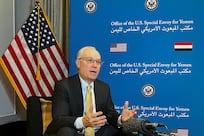Lockheed Martin is working on supersonic flight research with Nasa at its Advanced Development Projects division known as the "Skunk Works" in Palmdale, California.
The project "focuses on making supersonic flight feasible in the commercial realm by mitigating the impact of sonic booms over land," a Lockheed spokeswoman said. While Lockheed has a concept aircraft, like Gulfstream there is no prototype and its commercialisation programme has a longer timescale.
Aerion, an independent design company in the United States, has come up with a concept and is looking for a major planemaker partner to build a prototype.
Aerion envisions a "low-sweep, thin-wing" design that makes flying at high subsonic and supersonic speeds highly fuel efficient.
The jet would seat up to 12 and fly from New York to Paris in four hours, compared to seven and a half hours by conventional jet. Aerion estimates it can deliver a supersonic business jet at US$80 million (Dh293.8m) per aircraft, and it says it has received letters of intent for about 50 jets from individuals and corporations around the world.
"The market is very large and is ready for such an aircraft, with somewhere between 400 and 600 deliveries over the first 15 years or so of the programme," said Douglas Nichols, Aerion's chief operating officer. "Our technology is also highly scalable, for aircraft smaller or larger than our 12-passenger design. The overall market for the Aerion aircraft is enormous."
However, regulatory hurdles remain. The Federal Aviation Administration has banned supersonic overland flight in the US because of the sonic boom.
"If a rational rule for environmentally acceptable supersonic flight over land could be put in place, a supersonic airplane could come into existence," said the Gulfstream spokeswoman Heidi Fedak. "There just isn't a business case for it until those regulations are different."




